 |
 |
As you explore and enjoy this site, keep in mind that someone - an
individual person - gave his life or his freedom, so that today, you can
do something as trivial as collecting baseball cards, old license plates,
or old worn out jeeps. Do I enjoy collecting? YES, but in the big picture,
it is inconsequential when compared to giving up seeing your parents, siblings,
spouse and friends ever again. Imagine never being able to see your children
grow up. This risk is taken daily by the men & women of the armed forces,
coast guard, police, and fire dept.'s.
When you see someone on the streets who is serving or has served,
say "Thanks".
Keep those who have been taken from their loved ones in your thoughts
and prayers.
|
Histories: Gold Star Mothers and Blue Star "In Service" Flags WWRM
(WWII Families for the Return of the Missing)
Prisoner-Of-War
/ Missing-In-Action Vietnam Era Database
Advocacy &
Intelligence Index For POWs-MIAs Archives
WWII Japanese Atrocities : Cannibalization of US Pilots in Japan Histories:
The Vietnam Veterans Memorial
Virtual Name
Rubbings from "The Wall"
Histories: The Missing Man Formation Histories: The POW MIA Bracelet Returning A POW MIA Bracelet To Family Procedure The
History and Origin of POW/MIA Bracelets
New
Production POW Bracelets
Left Behind? <snip>Starting in 1979 and continuing into the early 1980's, POW films would revisit Vietnam and the POW image in superhero rescue films. Evidence that North Vietnam had not returned all of our prisoners of war trickled into the popular culture's radar screen and started to play out in the medium of film, which attracted a huge audience. Characters such as Rambo not only combat North Vietnamese but also government officials who do not want it revealed that prisoners are still being held. This reflects the widespread publicity of the POW myth. Further lending high profile support to the cause was former President Ronald Reagan, who promised he would make finding any remaining POWs a national priority.<snip> follow link for more... Are there any still left behind? here is just one document, even if you only read the first 2 paragraphs, it should keep you wondering if there are some left behind alive. MISSING MAN TABLE & HONORS CEREMONY |
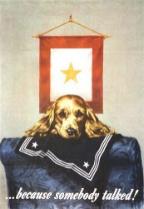
|
|
|
|

1941-1945 |

1950-1953 |
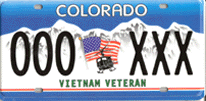
1961-1975 |
The 2 bracelets below are mine.
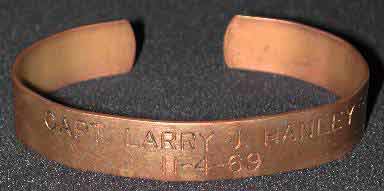
UPDATE #1: I received an email from Larry's family.
Hello Brian,Hello Darlene. Thank you for writing. I am so glad you did. It is almost 1am here, so this email will be short. I will write again as I get more time.
Let me introduce myself -- I am Larry’s sister. I was surfing the internet yesterday, starting at google.com, and just happened to click on your website address. I scrolled down through your site, read some of the things, and I almost clicked out of it when I just happened scroll one more screen and was so surprised when there right before my eyes was Larry’s POW bracelet.This has been a remarkable year for my family as more and more we have come into contact with people (through the help of computers and the internet) from all over who have some interest in Larry. I would be interested in how you happen to have a bracelet with his name on it.
I thought it only fair that I at least e-mail you and say thank you for caring – not only for my brother but obviously for many, many others. I did notice, however, that some of the information you have on your bio of Larry is not correct. If you ever want to change it, please feel free to contact me.
Thank you again for caring,
Darlene
UPDATE #2: I received an email from someone looking for Larry's family.
Brian - I could not believe that I fell into this website and found an email from Larry's sister!
I wore Larry's bracelet for years and corresponded with his mother, Florence K for years.... Please help me get in contact with his sister, Darlene -- did Darlene indicate her last name or is she living in Walla Walla?
I have been to the Wall in DC and climbed up on my son's shoulders so that I could touch Larry's name.... I still have his bracelet and I plan to visit the Visiting Memorial Wall when it comes to the Hillsboro Air Show Aug 28th this year...
Most sincerely,
Julie Martin (my name was Julie Olson, Menomonee Falls, Wis when I was writing to Florence many years ago)
Thank you so very very much
Juli - Juliex.a.martin@intel.comPS. I wore his bracelet for a long time, so it'd be in any of my photos, but none that would showcase my wrist with his bracelet. I did have 2 of his bracelets, one of which I mounted on a plaque and sent to Florence many many years ago.
I'll keep going back to the post in hopes of hearing from his family.
Thank you again and God Bless!!!!!
Juli
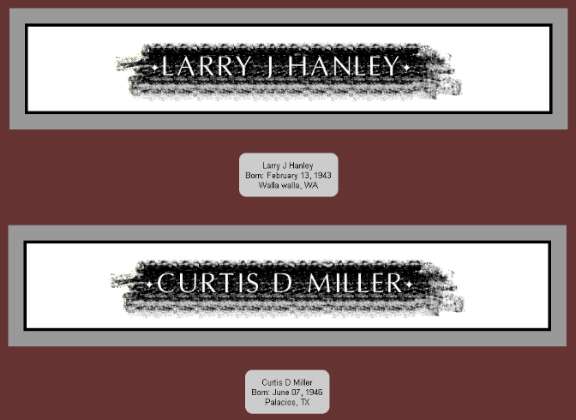
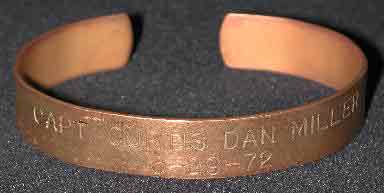
MILLER, CURTIS DANIEL
STATUS: XX - PRESUMPTIVE FINDING OF DEATH
VEHICLE TYPE: AC130A
Name: Curtis Daniel Miller
Rank/Branch: O3/US Air Force
Unit: 16th Special Operations Squadron, Ubon Airfield, Thailand
Date of Birth: 07 June 1946
Home City of Record: Palacios TX
Date of Loss: 29 March 1972
Country of Loss: Laos
Loss Coordinates: 163900N 1060600E (XD165414)
Status (in 1973): Missing In Action
Category: 2
Aircraft: AC130A
Other Personnel In Incident: Henry Brauner; Barclay Young; Howard Stephenson; James Caniford; Robert Simmons; Edwin Pearce (all missing); Edward Smith; Richard Halpin; Irving Ramsower; Richard Castillo; Charles Wanzel; Merlyn Paulson; William Todd; (remains returned)
Source: Compiled by Homecoming II Project 15 March 1991 from one or more of the following: raw data from U.S. Government agency sources, correspondence with POW/MIA families, published sources, interviews. Updated by the P.O.W. NETWORK 1998.
REMARKS: NO PARACHUTES - NO RADIO CONTACT - SEARCH AND RESCUE NEGATIVE
SYNOPSIS: On the night of March 29, 1972, an AC130A Hercules "Spectre"
gunship departed Ubon Airfield, Thailand on a night reconnaissance mission
over supply
routes used by North Vietnamese forces in Laos. The crew of the aircraft
consisted of pilots Maj. Irving B. Ramsower II and 1Lt. Charles J. Wanzel
III, the navigator, Maj. Henry P. Brauner, and crew members Maj. Howard
D. Stephenson, Capt. Curtis D. Miller, Capt. Barclay B. Young, Capt. Richard
Castillo, Capt. Richard C. Halpin, SSgt. Merlyn L. Paulson, SSgt. Edwin
J. Pearce, SSgt. Edward D. Smith Jr., SSgt. James K. Caniford; and Airmen
First Class William A. Todd and Robert E. Simmons. As the aircraft was
in the jungle foothills 56 miles east of Savannakhet in southern Laos,
it was shot down by a Russian Surface to Air Missile (SAM). U.S.
government sources stated in February 1986 that a fighter escort plane
reported that the aircraft crashed in a fireball, no parachutes were seen,
nor was radio contact made with the AC130 or any of its crew. In 1972,
however, the Pearce family was told that an F4 support plane traveling
with the AC130 heard "so many beepers they couldn't count them" and that
the emergency beeper type carried by the crew could only be activated manually.
The Pearce family took this as strong proof that a number of the crew survived.
The support aircraft plane left the area to refuel. When it returned, there
were no signs of life.
The inscribed wedding band of Curtis Miller was recovered by a reporter and returned to Miller's family. The existence of the ring suggests to Miller's mother that the plane did not burn, and gives her hope that he survived.
A May 1985 article appearing in a Thai newspaper stated that the bodies of Simmons and Wanzel were among 5 bodies brought to the base camp of Lao Liberation forces. The same article reported a group of 21 Americans still alive, held prisoner at a camp in Khammouane Province, Laos. At about this same time, Simmons' dog tag was mailed anonymously to the U.S. Embassy in Laos. FBI tests failed to show fire residue on the tag, proving to the Simmons family that Skeeter did not die in the explosion and go down in the fiery crash.
The U.S. and Laos excavated this aircraft's crash site in February 1986. The teams recovered a limited number of human bone fragments, personal effects and large pieces of plane wreckage. It was later announced by the U.S. Government that the remains of Castillo, Halpin, Ramsower, Simmons, Todd, Paulson, Pearce, Wanzel and Smith had been positively identified from these bone fragments.
In a previous excavation at Pakse, Laos in 1985, remains recovered were positively identified as the 13 crew members, although independent examiners later proved that only 2 of those identifications were scientifically possible. The U.S. Government has acknowledged the errors made in identification on two of the men, but these two individuals are still considered "accounted for".
Because of the identification problems of the first excavation, the families of the Savannakhet AC130 have carefully considered the information given them about their loved ones. The families of Robert Simmons and Edwin Pearce have actively resisted the U.S. Government's identification, which is in both cases based on a single tooth. These families do not know if their men are alive or dead, but will insist that the books are kept open until proof dictates that there is no longer any hope for their survival.
In January 1991, a federal judge ruled that when the Simmons family collected death benefits for Skeeter, they lost the right to question whether he was dead. They have continued to fight a positive identification based on a single tooth. The Assistant U.S. Attorney, William H. Pease, added that the court has no jurisdiction over military identification of remains.
Nearly 600 Americans were lost in Laos during the Vietnam war, and many
were known to have survived their loss incident. However, the U.S. did
not negotiate
with Laos for these men, and consequently, not one American held in
Laos has ever been released.
Date of Birth: 07 June 1946
Home of Record: Palacios, TX
Date of Loss: 29 March 1972
Country of Loss: Laos
Loss Coordinates: 163900N 1060600E (XD165414)
Click coordinates to view (4) maps
Status in 1973: Missing In Action
Category: 2
Aircraft/Vehicle/Ground: AC130A "Spectre"
Other Personnel in Incident: Barclay B. Young; Howard D. Stephenson;
Henry P. Brauner and James K. Caniford, (missing); Edwin Pearce and Robert
Simmons (contested remains identification); Richard Castillo; Richard C.
Halpin; Edward D. Smith, Jr.; Charles J. Wanzel III; Merlyn Paulson; Irving
B. Ramsower II and William A. Todd (remains returned).
REMARKS: NO PARA - NO RAD CNTCT - SAR NEGA
SYNOPSIS: The Lockheed AC130A Spectre gunship first made its trial appearance in Vietnam in late 1967. Because it was highly maneuverable at low speeds and could spend hours in an operational area while delivering a precisely placed stream of withering fire on a target, it immediately proved its worth in combat. By early 1969, seven AC130A gunships were deployed to SEA. These originally deployed AC130A were armed with four M61 Vulcan 20mm cannons mounted in the first half of the fuselage. Each was capable of delivering a maximum of 2,500 shots per minute. Further, each Spectre also had four 7.62mm miniguns that could fire 3,000 or 6,000 shots per minute. In 1969-1970, two of the miniguns and two of the 20mm cannons were removed to make room for the addition of a pair of 40mm Bofors cannons that were mounted in the aft section of the aircraft. While capable of delivering 110 shots per minute, they were generally used to fire 3 to 4 round bursts of fire one gun at a time. The second generation AC130E/H models arrived in 1972 armed with two Vulcan 20mm cannons, one 40mm Bofors cannon and a 105mm Howitzer. This modification, along with a sophisticated fire control system, made the gunship an extremely affective tank killer as well as an equally effective weapon for interdicting enemy traffic along the Ho Chi Minh Trail.
On 29 March 1972, Major Irving B. Ramsower II, aircraft commander; Capt. Curtis D. Miller, pilot; 1st Lt. Charles J. Wanzel III, pilot; then Major Henry P. Brauner, navigator; Capt. Richard Castillo, infrared sensor operator; Major Howard D. Stephenson, electronic warfare officer; Capt. Barclay B. Young, fire control officer; Capt. Richard C. Halpin, low light TV senior operator; SSgt. James K. Caniford, illuminator operator; SSgt. Merlyn Paulson, flight engineer; SSgt. Edward D. Smith, Jr., aerial gunner; SSgt. Edwin Pearce, aerial gunner; AFC William A. Todd, aerial gunner and AFC Robert E. Simmons, aerial gunner; comprised the crew of an AC130A gunship named "Prometheus," tail number 55-0044, and call sign "Spectre 13." They departed Ubon Airbase, Thailand on an armed reconnaissance mission with an F4D fighter escort over Laos to interdict North Vietnamese supplies moving south into the acknowledged war zone, then return to Ubon.
This area of Laos was considered a major artery of the infamous Ho Chi Minh Trail. When North Vietnam began to increase its military strength in South Vietnam, NVA and Viet Cong troops again intruded on neutral Laos for sanctuary, as the Viet Minh had done during the war with the French some years before. This border road was used by the Communists to transport weapons, supplies and troops from North Vietnam into South Vietnam, and was frequently no more than a path cut through the jungle covered mountains. US forces used all assets available to them to stop this flow of men and supplies from moving south into the war zone.
At 0300 hours, the F4D's aircrew saw a surface to air missile (SAM) lift off the ground. Before the gunship could take evasive action, the SAM hit Specter 13. A few seconds later the AC130A impacted the ground on the east side of a jungle covered mountain followed by secondary explosions. A north/south running power transmission line ran along a ridgeline just east of the crash site and approximately 1 mile to the east ran a long somewhat pear shaped jungle covered valley through which major arteries of the Ho Chi Minh Trail ran. The communist stronghold in and around the town of Tchepone lay across the valley. As one of the F4D escort aircraft flew low over the burning wreckage, he was unable see any sign of survivors. However, several minutes later as he was departing the area he clearly heard multiple emergency beepers. Another AC130A gunship operating nearby, call sign "Spectre 10," and his F4 escort also heard the beeper signals. In the darkness, no parachutes were seen and no voice contact could be established with any of the downed aircrew. The wreckage of Prometheus was located in the jungle-covered mountains approximately 12 miles south of Ban Namm, 21 miles west of Tchepone, 56 miles east of the city of Savannakhet and 32 miles west of the Lao/Vietnamese border, Savannakhet Province, Laos; and 45 miles due west of Khe Sanh, South Vietnam.
At 0350 hours, a Forward Air Controller (FAC), call sign "Nail," arrived on station to cover the crash site area and control the search and rescue (SAR) efforts that were immediately initiated. Unfortunately, by the time he arrived on site, he was unable to hear the emergency beepers. Likewise, in the darkness he was unable to locate any signs of survivors. Formal electronic surveillance efforts continued both day and night. In addition, all aircraft flying near the loss area listened for possible signals or mayday's from the downed crew members. All SAR efforts were terminated at 1830 hours on 30 March 1972 when no trace of the downed crew was found. Because of the heavy enemy activity in the area including numerous anti-aircraft artillery (AAA) and surface-to-air missile SAM sites, as well as a large concentration of NVA forces, it was believed any surviving crewmen would have undoubtedly been captured by then. All 14 crewmen were listed Missing in Action.
During the 1970s and early 1980s various reports pertaining to crew members of Spectre 13 were received by the US government. These reports ranged from crash site/grave site data to multiple live siting reports. One of these reports was provided by a communist rallier who stated his unit was at an outpost near "38th MIL station Savannakhet" when a NVA convoy of some 130 trucks moved through his area between 35th to 38th MIL stations. The convoy was attacked by one C130 aircraft and two F4 fighters. According to the source, he observed the aircraft making several passes on the convoy destroying parts of it on each pass. When the Americans made their fifth pass, the C130 was hit and crashed approximately 10 kilometers south of his location. Most of the personnel from the 38th station rushed to the crash site. When they returned, they told the source who stayed at the station, that nine of the American crewmen had been rescued by Laotian civilians living near the crash site.
In 1984, remains reportedly belonging to William Todd were provided by a Lao refugee to US officials. Those remains consisted of 5 small bone fragments that were forwarded to the Central Identification Laboratory-Hawaii (CIL-HI) on 20 November 1984. Subsequently, they were determined to be portions from the distal portions of a radius or a fibula. These remains were insufficient in quantity to determine race, sex or identity. Along with the bone fragments, identification media data in the form of a dog tag bearing AFC Todd's name and information was also forwarded with the remains to the laboratory.
Also in 1984, Curtis Miller was the subject of a first-hand live sighting refugee report wherein "the prisoner with a ring on his finger" was still alive and held captive. That wedding ring became another piece of material evidence supporting the fact that some of the crew successfully bailed out of their crippled gunship. This ring, inscribed on the inside "Forever Sue," was returned to Capt. Miller's family by the reporter who recovered it while visiting Laos. Interestingly, the ring was not burned or damaged in any way. That fact strongly supports the belief he was one of the men who bailed out before it impacted the ground.
A May 1985 article appearing in a Thai newspaper stated that the bodies of Robert Simmons and Charles Wanzel were among 5 bodies brought to the base camp of Lao Liberation forces. No names were associated with the other 3 sets of partial remains, and while the article named 2 names, it did not provide any information of when or how the men died. The same article reported a group of 21 Americans still alive and being held in a prison camp in Khammouane Province, Laos.
A joint US/Lao team excavated Spectre 13's crash site in February 1986. They recovered a very limited number of human bone fragments, personal effects and large pieces of aircraft wreckage that were turned over to the appropriate agency for evaluation on 1 March 1986. That portion of recovered remains associated with Robert Simmons consisted of only the #14 tooth - the upper left first molar. According to his dental records, that tooth is the only one he had extracted before going to Vietnam! His family categorically rejects that tooth as Robert Simmons mortal remains. Likewise, only one tooth, along with a dog tag that was recovered in Thailand a year earlier, was identified as the total mortal remains of Edwin Pearce. His family also rejects the US government considering him to be remains returned based on one tooth.
Likewise, based on claims made by CIL-HI's forensic personnel, Richard Halpin, Richard Castillo, Irving Ramsower, Charles Wanzel, Merlyn Paulson, and Edward Smith were identified and remains accepted by their families. CIL-HI personnel added the 5 bone fragments and dog tag that were previously turned over to US representatives to those recovered from the crash site excavation to account for William Todd as being remains returned/recovered. His family also accepted the government's identification.
Henry Brauner, Barclay Young, Curtis Miller, Howard Stephenson, James Caniford, Edwin Pearce and Robert Simmons are among nearly 600 Americans who disappeared in Laos. Many of these men were known to be alive on the ground. The Laotians admitted holding "tens of tens" of American Prisoners of War, but these men were never negotiated for either by direct negotiation between our countries or through the Paris Peace Accords which ended the War in Vietnam since Laos was not a party to that agreement.
While the fates of some members of this aircrew are finally resolved and their families have the peace of mind of knowing where their loved ones now lie, there are no answers to the questions of when and how each man died. For other Americans who remain unaccounted for, including other crewmen from Spectre 13, there remain only unanswered questions.
Since the end of the Vietnam War well over 21,000 reports of American prisoners, missing and otherwise unaccounted for have been received by our government. Many of these reports document LIVE America Prisoners of War remaining captive throughout Southeast Asia TODAY.
Pilots and aircrews in Vietnam and Laos were called upon to fly in many
dangerous circumstances, and they were prepared to be wounded, killed or
captured. It probably never occurred to them that they could be abandoned
by the country they so proudly served.
| BACK TO
|
|||||
| Table
of
Contents |
Post
your Free
Classified Ads |
Link
to this
website |
Navigation
Help |
||
![]()
Please don't pirate my pictures or text. Ask
my permission.
Copyright
© 1998-2011 Brian French. All Rights Reserved